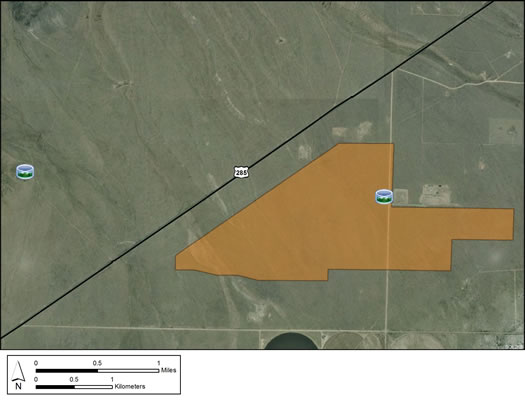The Approved Record of Decision for Resource Management Plan Amendments for Utility-Scale Solar Energy Development was issued on December 20th, 2024 — details are available on the BLM's Utility-Scale Solar Energy Development PEIS/RMPA webpage. Relevant information on the 2024 Western Solar Plan and the BLM's Renewable Energy Rule issued in July 2024, is in the process of being updated on this website.
| Colorado Variance Areas | De Tilla Gulch SEZ |
 |
 |
The De Tilla Gulch Solar Energy Zone (SEZ) is a designated leasing area (DLA) located in Colorado in a high-elevation basin within the Rocky Mountains. The SEZ is located on BLM-administered land within the Saguache Field Office.
The De Tilla Gulch SEZ is the smallest of the SEZs. In the 2010 Draft Solar PEIS, the proposed total area of the SEZ was 1,522 acres (6.2 km2). In the 2011 Supplement to the Draft, 458 acres (1.9 km2) along the northwest edge of the SEZ were eliminated to reduce impacts on various resources. The remaining SEZ developable area is 1,064 acres (4.3 km2). No additional changes to the SEZ developable area were made in the 2012 Final Solar PEIS.
The De Tilla Gulch SEZ is located in Saguache County in south-central Colorado, in the northwestern portion of the San Luis Valley, part of the San Luis Basin, a large, high-elevation basin within the Rocky Mountains. The San Juan Mountains to the west and the Sangre de Cristo Range to the east form the rim of the basin. In 2008, the county population was 6,903, while the surrounding four-county region had a total population of 51,974. The largest nearby town of Alamosa is located about 50 mi (80 km) to the south.

The De Tilla Gulch SEZ is in a gently sloping treeless plain, and scrubland vegetation reflects the arid climate. Vegetation is primarily low shrubs and grasses, with many areas of bare, generally tan soil or gravel. The SEZ is intersected with dry streambeds. Annual rainfall averages about 8 in. (20 cm).
Unpaved roads cross the SEZ, and some cleared areas are located in the northeastern portion of the SEZ where sand and gravel have been removed. The SEZ contains a windmill, wire fences, and a transmission line that runs north to south along the road on the eastern side of the SEZ. Part of the SEZ is authorized by the BLM for grazing.
Little commercial or industrial activity exists in the surrounding area. A small landfill is located northeast of the SEZ, as are transmission lines and towers. Agricultural areas lie to the east and to the south.

U.S. 285 borders the northwest boundary of the SEZ. An existing 115‑kV transmission line is accessible to the SEZ.
In the 2012 Solar PEIS, the BLM committed to establishing a monitoring and adaptive management strategy for each solar energy zone (SEZ). Through these strategies, the BLM will take an active role in the collection of baseline data for the SEZs.
The BLM has not yet begun the monitoring and adaptive management strategy for the De Tilla Gulch SEZ. However, the BLM has conducted a pilot monitoring and adaptive management strategy for the Riverside East SEZ. In May 2016, the BLM released the Riverside East Solar Energy Zone Long Term Monitoring Strategy Final Report. The monitoring strategy document (PDF, 16.6 MB) is now available.
In the 2012 Solar PEIS, the BLM committed to preparing solar regional mitigation strategies (SRMSs) for the solar energy zones (SEZs). These regional mitigation strategies were intended to simplify and improve the mitigation process for future solar projects in SEZs.
In January 2017, the BLM released the Regional Mitigation Strategy for the Colorado Solar Energy Zones – Final Report (PDF, 26.1 MB). This document addresses regional mitigation for the De Tilla Gulch SEZ and two other SEZs in Colorado's San Luis Valley. Additional supporting studies were released with the Regional Mitigation Strategy; all the documents are available through the BLM's Renewable Energy Mitigation webpage.
With IM-2019-018, the BLM established policy that compensatory mitigation could not be required as a condition for project approvals. However, with the issuance of IM 2021-038 on July 14, 2021, the BLM rescinded the previous IM-2019-018. The BLM expects to establish policies which are aligned with EO 13990, SO 3398, and the priorities of the Department. During this interim period offices should consider and implement compensatory mitigation on a case-by-case basis, in consultation with state office and national office program specialists and the Office of the Solicitor as needed.